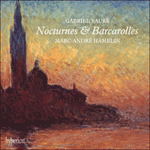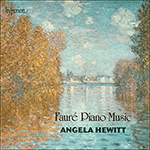Written in 1921, three years before fauré’s death, the tragic despair of the
Thirteenth Nocturne shares its depth of feeling with few other works in the piano repertoire. Certainly nothing like this was written by Debussy or Ravel, and only in the last pages of Beethoven, Schubert, Mozart or Bach can parallels be found to its austere heartbreak. The work can be regarded as autobiographical. For the last few years of his life the composer suffered from a distressing hearing defect which caused him to hear distortion in the higher frequencies of the sound spectrum. Knowing this, the chains of suspensions which open this last Nocturne take on an added significance. (One is reminded of the last movement of Smetana’s Quartet ‘From my life’ where the piercing high E of the violin symbolizes the sound he heard in his head; he suffered from tinnitus.) The piece as a whole is filled with a feeling of regret and valediction, with a vehement and angry middle section rising to a climax of the greatest fury. Because one knows and loves Fauré for his understating of such feelings, the unmistakable note of despair which this reveals is all the more affecting. It ends on a note of utter resignation, the music of a man on the threshold of death. This music does not reveal its secrets easily and at first may appear arid and academic. But the essence of Fauré is in it, and not until one has entered its tragic world can one truly be said to understand him.
from notes by Ted Perry © 1999
Ultime composition pianistique de Fauré, cette pièce surprenante, écrite en 1921, trois ans avant la mort de l’artiste, recèle un désespoir tragique dont la profondeur ne se rencontre que dans quelques rares œuvres du répertoire pour piano. Debussy ou Ravel n’écrivirent certainement rien d’équivalent, et l’austère déchirement de cette pièce ne trouve de parallèle que dans les dernières pages de Beethoven, Schubert, Mozart ou Bach. Cette composition peut être considérée comme autobiographique, car Fauré souffrit, dans les dernières années de sa vie, d’un pénible défaut d’audition, qui lui faisait entendre des distorsions dans les fréquences supérieures du spectre sonore—les chaînes de retard qui ouvrent ce dernier nocturne revêtent dès lors une importance accrue. (Dans le dernier mouvement du Quatuor «De ma vie» de Smetana, le perçant mi aigu du violon symbolise, à l’identique, le son que le musicien entendait dans sa tête—il souffrait d’acouphène.) La pièce est globalement emplie d’un sentiment de regret et d’adieu, avec une section centrale véhémente et irritée, qui atteint à un apogée des plus furieux. Que l’on connaisse, et que l’on aime, Fauré pour ses litotes quant à pareils sentiments, ne fait que rendre plus touchante l’immanquable note de désespoir révélée par cette pièce. L’œuvre s’achève sur une résignation absolue—la musique d’un homme au seuil de la mort. Cette musique ne dévoile pas facilement ses secrets et pourrait, de prime abord, sembler aride et académique. Mais elle recèle l’essence de Fauré, et c’est seulement après avoir pénétré son univers tragique que l’on peut déclarer véritablement comprendre ce compositeur.
extrait des notes rédigées par Ted Perry © 1999
Français: Hypérion
Das 1921, drei Jahre vor Faurés Tod entstandene
Dreizehnte Nocturne teilt seine Gefühlstiefe mit wenigen anderen Werken im Klavierrepertoire. Auf jeden Fall haben weder Debussy noch Ravel etwas Vergleichbares geschrieben, und erst auf den letzten Seiten des Gesamtwerks von Beethoven, Schubert, Mozart oder Bach finden sich Parallelen zu seiner kargen, herzzerreißenden Atmosphäre. Dieses Werk kann als autobiographisch angesehen werden. In den letzten Jahren seines Lebens litt der Komponist unter einem quälenden Gehörschaden, der dazu führte, daß er in den höheren Frequenzen des Klangspektrums Verzerrungen hörte. In Anbetracht dessen nehmen die aneinandergereihten Vorhalte, die das letzte Nocturne einleiten, zusätzliche Bedeutung an. (Man fühlt sich an den letzten Satz von Smetanas Quartett „Aus meinem Leben“ erinnert, wo das durchdringende hohe E der Violine das Geräusch verkörpert, das er in seinem Kopf hörte: Er litt unter Tinnitus.) Das Stück ist insgesamt mit einem Gefühl des Bedauerns und des Abschiednehmens erfüllt, und ein heftiger, aufbrausender Mittelteil steigert sich zu einem Höhepunkt äußerster Wut. Gerade weil man Fauré wegen seiner Zurückhaltung bei derlei Gefühlsäußerungen kennt und liebt, ist die unverkennbare Verzweiflung, der sich hier offenbart, umso ergreifender. Das Stück endet mit einem Anflug gänzlicher Resignation—der Musik eines Mannes an der Schwelle des Todes. Diese Musik verrät nicht ohne weiteres ihre Geheimnisse und mag zunächst trocken und akademisch wirken. Doch sie enthält die Essenz Faurés, und man kann erst von sich behaupten, ihn zu verstehen, wenn man in ihre tragische Welt eingedrungen ist.
aus dem Begleittext von Ted Perry © 1999
Deutsch: Anne Steeb/Bernd Müller

 Fauré: Nocturnes & Barcarolles
Fauré: Nocturnes & Barcarolles Fauré: Piano Music
Fauré: Piano Music Fauré: Piano Music
Fauré: Piano Music
